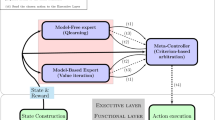Abstract
This paper investigates the effectiveness of using the Contract Net Protocol, an auction type system, for controlling task allocation among a group of robots, and presents and evaluates a strategy of using Artificial Neural Networks to formulate adaptive bids within the framework of the Contract Net Protocol. The robots were used in a foraging environment and showed that excellent communication among robots leads to a need for a social control mechanism for managing the robots, such as the Contract Net Protocol. The experiments also confirmed that a moderate benefit can be gained by using adaptive bidding within the framework of the Contract Net Protocol.
Similar content being viewed by others
References
Assoun MH (1995) Fundamentals of artificial neural networks. MIT Press, Cambridge
Bond AH, Gasser L (1988) Distributed artificial intelligence. Morgan Kaufmann, San Francisco
Cao YU, Fukunaga AS, Kahng A (1997) Cooperative mobile robotics: antecendents and directions. Auton Robots 4:7–27
Cheng B, Titterington DM (1994) Neural networks: a review from a statistical perspective. Stat Sci 9(1):2–30
comp.ai.neural-nets. How many hidden units should I use? http://www.faqs.org/faqs/ai-faq/neural-nets/part3/index.html. Accessed May 2007
Davis R, Smith RG (1988) Negotiation as a metaphor for distributed problem solving. In: Bond AH, Gasser L (eds) Distributed artificial intelligence. Morgan Kaufmann, San Francisco, pp 333–356
Ebay. http://pages.ebay.com/help/buy/buyer-multiple.html. Accessed May 2007
Geman S, Bienenstock E, Doursat R (1991) Neural networks and the bias/variance dilemma. Neural Comput 4:1–58
Gerkey BP, Mataric MJ (2002) A market-based formulation of sensor-actuator network coordination. In: Proceedings of the AAAI spring symposium on intelligent embedded and distributed systems, Palo Alto, CA, March 2002, pp 21–26
Gerkey BP, Mataric MJ (2002) Sold!: auction methods for multirobot coordination. IEEE Trans Robot Autom 18(5):758–768
Glasius R, Komoda A, Gielen SC (1995) Neural network dynamics for path planning and obstacle avoidance. Neural Netw 8(1):125–133
Golfarelli M, Maio D, Rizzi S (1997) Multi-agent path planning based on task-swap negotiation. In: Proceedings of the 16th UK planning and scheduling SIG workshop. Durham, pp 69–82
Gun-Tactyx. http://gameprog.it/hosted/guntactyx/. Accessed May 2007
IBM. http://www-128.ibm.com/developerworks/java/library/j-robocode/. Accessed May 2007
Joone. http://www.joone.org/. Accessed May 2007
Kensler JA (2007) On adaptive bidding with the contract net protocol for task allocation in multi-robot systems. MS thesis, Computer Science, University of Kansas, May 2007
Lemaire T, Alami R, Lacroix S (2004) A distributed tasks allocation scheme in multi-UAV context. In: Proceedings of the IEEE international conference on robotics and automation, vol 4, New Orleans, LA, April 2004, pp 3622–3627
McCullagh P, Nelder JA (1989) Generalized linear models, 2nd edn. Chapman & Hall, London
Moses Y, Tennenholtz M (1995) Artificial social systems. Comput Artif Intell 14(6):533–562
Muller B, Reinhardt J (1990) Neural networks: an introduction. Springer, New York
Parker LE (1998) ALLIANCE, an architecture for fault-tolerant multi-robot cooperation. IEEE Trans Robot Autom 14(2):220–240
RoboCode. http://robocode.sourceforge.net/docs/robocode/. Accessed May 2007
Russell S, Norvig P (2003) Artificial intelligence: a modern approach, 2nd edn. Prentice Hall, Pearson Education, Upper Saddle River
Sandholm T, Lesser V (1996) Advantages of a Leveled commitment contracting protocol. In: Proceedings of the thirteenth national conference on artificial intelligence. AAAI Press, Menlo Park, pp 126–133
Sandholm, Lesser (1995) Issues in automated negotiation and electronic commerce: extending the contract net framework. In: Proceedings of the 1st international conference on multi-agent systems, San Francisco, CA, pp 328–335
Scerri P, Vincent R, Mailler RT (2005) Coordination of large-scale multiagent systems. Springer, New York
Shehory O, Kraus S (1998) Methods for task allocation via agent coalition formation. Artif Intell 101(1–2):165–200
Shoham Y, Tennenholtz M (1994) Co-learning and the evolution of social activity. Technical Report STAN-CS-TR-94-1511, Stanford University
Shoham Y, Tennenholtz M (1992) On the synthesis of useful social laws for artificial agent societies. In: Proceedings of the tenth national conference on artificial intelligence, San Diego, pp 704–709
Smith RG (1980) The contract net protocol: high-level communication and control in a distributed problem solver. IEEE Trans Comput C-29(12):1104–1113
TeamBots. http://www.teambots.org/. Accessed May 2007
Weiss G (1999) Multiagent systems: a modern approach to distributed artificial intelligence. MIT Press, Cambridge
Zlot RM, Stentz A, Dias MB, Thayer S (2002) Multi-robot exploration controlled by a market economy. In: Proceedings of the IEEE international conference on robotics and automation, vol 3, pp 3016–3023
Author information
Authors and Affiliations
Corresponding author
Rights and permissions
About this article
Cite this article
Kensler, J.A., Agah, A. Neural networks-based adaptive bidding with the contract net protocol in multi-robot systems. Appl Intell 31, 347–362 (2009). https://doi.org/10.1007/s10489-008-0131-1
Received:
Accepted:
Published:
Issue Date:
DOI: https://doi.org/10.1007/s10489-008-0131-1




